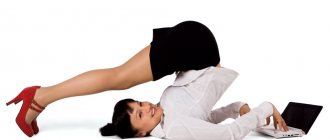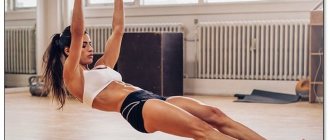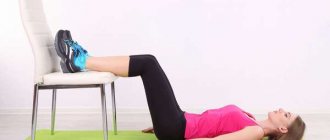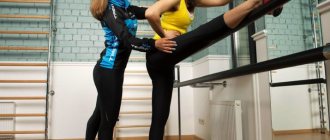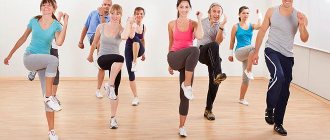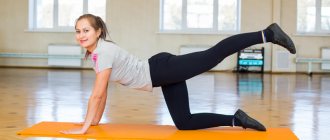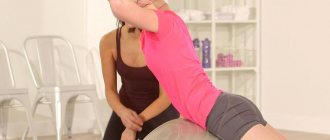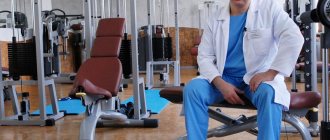It is well known that playing sports is the key to maintaining good physical shape and improving human health. Over the millennia, humanity has invented dozens and hundreds of options for physical training, competitions and forms of sports, not only as competitive disciplines, but also to improve health for preventive purposes.
One of the most popular and effective types of physical activity for strengthening general health is gymnastics.
Gymnastics (from the Greek “gymnastike”, from “gymnazo” - I train, exercise) is a system of specially selected physical exercises that have a complex effect on the human body, developing its physical capabilities.
For every person, regardless of age and gender, there is a suitable type of gymnastics.
Popular types of gymnastics include: artistic, artistic, acrobatic, aesthetic, team, aerobic. It is well known that playing sports is the key to maintaining good physical shape and improving health.
Over the millennia, humanity has invented dozens and hundreds of variants of competitions, disciplines and forms of sports. One of these types of physical activity is gymnastics.
Gymnastics - what is it and why is it necessary?
The concept of gymnastics combines a variety of physical exercises that contribute to the development or improvement of existing motor skills in those involved.
A distinctive feature of gymnastics from other sports is its versatile and harmonious effect on the human body.
Gymnastic exercises cover all parts of the musculoskeletal system, evenly develop muscles and improve coordination. At the same time, gymnastics affects not only the physical condition of a person, but also forms certain moral and volitional qualities.
It is considered one of the most important components of introducing the population to sports. Gymnastics can be found in schools and kindergartens, it is practiced at home and in fitness centers, and is used in manufacturing enterprises and in medicine.
The variety of gymnastic exercises made it necessary to systematize the types of gymnastics, which was done at the All-Union Conference in 1984.
In general, all areas of gymnastics are combined into several large groups:
- health-improving gymnastics, varieties of which are aimed at strengthening human health (the existing classification includes more than 30 of them);
- artistic gymnastics, which, in essence, is a professional sport;
- educational and developmental types that pursue not only health-improving goals, but also educational and training ones.
Don’t miss the most popular article in the section: Glutamic acid - what it is, why and how it is used in sports and bodybuilding.
Where can I find gymnastics exercises for beginners?
If you decide to do gymnastics at home and don’t want to turn to an instructor for help, then this is what will help you. With the help of the video, you can choose the necessary set of exercises and the technique for performing them.
Videos can be viewed on the Internet, you can download them or buy them in specialized stores. There is a video that shows you a variety of exercises, there is a video with theory, and there is a video with recommendations from doctors. You can find videos with ready-made gymnastics and a set of exercises, so you don’t have to create anything yourself.
Rhythmic gymnastics is one of the most popular sports for girls. And this is not surprising; young gymnasts are delighted with the bright costumes, communication with their peers and their first small victories. For parents, in turn, it is important that their girls grow up graceful, strong and successful. Gymnastics is the ideal sport to achieve these goals. It includes dance elements, acrobatic sketches and good psychological preparation. Thanks to this, they have grace, plasticity, flexibility, a sense of rhythm and psychological stability.
It is important for parents that their girls grow up graceful, strong and successful.
Parents should know that behind the external gloss of this romantic sport there can be a hidden world: first defeats and disappointments, hard work and even injuries to your child. You should also correlate your desires with your financial capabilities; gymnastics is not a cheap sport. Sewing bright suits, purchasing the necessary equipment and shoes will fall on the shoulders of the parents.
Having assessed the pros and cons of the sport, as well as the potential and desire of you and your child, you must definitely send your girl to learn rhythmic gymnastics.
Health-improving gymnastics
Health-improving gymnastics is one of the forms of physical education, which, as a rule, does not require good physical preparation and is aimed at the general improvement of a person , improving the current state of the body, increasing efficiency and quality of life.
To practice recreational gymnastics, no special physical training is required.
Some types of health-improving gymnastics have long received well-deserved recognition, others are only gaining popularity in the last few decades.
Morning exercises (exercises)
Charging involves a set of simple exercises aimed at activating physiological processes in the body after waking up.
Basic movements:
- turns and tilts of the head;
- rotational movements of the shoulders and torso;
- swing your arms and legs, etc.
A set of exercises lasting 15-20 minutes provides a charge of vivacity and positive mood for the whole day.
Morning exercises should begin with rotations and tilts of the head.
It has been scientifically proven that morning exercises have a beneficial effect on all organs and systems of human life:
- stimulates blood circulation and metabolism;
- optimizes the functioning of the heart and respiratory organs;
- develops muscles and joints;
- strengthens the immune system, etc.
Introductory gymnastics
Introductory gymnastics are small sets of exercises that have found their application in enterprises and organizations before the start of the working day. Their task is to ensure a person’s rapid entry into work .
Introductory gymnastics is carried out in factories before starting work.
Therefore, all exercises in their content and focus are as close as possible to the actions performed during work. As a natural result , staff performance increases.
In general, the following exercises are used:
- steps and running in place;
- various types of movements of the arms and body;
- muscle stretching exercises;
- exercises to improve concentration, etc.
The duration of the gymnastics is 5-7 minutes. Form of implementation: collectively or individually.
Physical education (physical education minutes in educational institutions)
Physical education is a type of gymnastic exercise that is used in educational institutions (mainly in primary schools and preschool institutions). Physical education sessions usually consist of 3-4 special exercises. Their duration does not exceed 1.5-2 minutes.
The form may be:
- dance;
- sports;
- motor - speech;
- warm-ups for fingers or eyes;
- breathing exercises.
Physical education lessons have proven to be an effective way to maintain students’ performance. It is noted that their implementation allows you to relax the nervous system and skeletal muscles that are tense from prolonged sitting at a desk.
Physical education helps improve the mental and physical performance of students.
In addition, physical education sessions provide necessary rest for the eyes and hearing organs. And ultimately, they help students overcome fatigue and drowsiness and relax mentally.
Hygienic gymnastics
The task of hygienic gymnastics is to ensure that the human body is maintained in the healthiest possible condition. A distinctive feature from other types of gymnastics is the combination of physical exercises with hardening elements and hygienic components (control of ambient temperature, clothing and footwear, hygiene, etc.).
Regardless of the type of hygienic gymnastics, the exercises can be performed at any age and with any physical fitness.
In addition to general strengthening exercises, stretching exercises are used. No improvised means are required.
Essentially, the concept of hygienic gymnastics combines the following types:
- morning exercises (exercises);
- gymnastics during the working day (introductory, physical education);
- evening exercises (before bedtime).
Hygienic gymnastics is suitable for people of any age and different levels of training.
Rhythmic gymnastics
Rhythmic gymnastics (rhythmics) - physical education classes in dance form. The exercises used are simple, but effective, because they cover all muscle groups. Their tempo, form and intensity depend on the music. Characteristic movements are: flexion and extension, turns and rotations, swinging legs and arms, running, jumping, jumping, etc.
Rhythmic gymnastics is a simple combination of exercises that are performed exclusively to rhythmic music.
Regular exercise has a beneficial effect on the functioning of the heart and lungs , strengthens muscles, develops endurance and a sense of rhythm. From an emotional point of view, rhythmic gymnastics improves mood, relieves tension and adds vitality.
Physiotherapy
Designed for the rehabilitation of patients with neurological and cardiac problems, injuries of various nature and origin, etc.
Therapeutic gymnastics is performed under the full supervision of the attending physician.
All therapeutic gymnastics exercises are performed statically , that is, as a rule, they are done slowly and under tension. Their action is aimed at improving the functioning of a specific organ. Therapeutic exercises are often combined with breathing exercises.
The scope of therapeutic exercises is very extensive:
- injuries and disorders of the musculoskeletal system (including immobilization);
- scoliosis;
- neurological diseases, etc.
Form of classes: in groups and individually. The general course of treatment usually consists of 3 stages: introductory, main and final.
Don't miss the most popular article in the section: Body drying for girls. Training program, detailed nutrition menu for the month by day.
Nutritional Features
Increased physical activity leads to increased energy expenditure in children. Therefore, it is important to organize a varied and nutritious diet for children. It is recommended to maintain the ratio of proteins, fats and carbohydrates in food (1:1:4).
It is necessary to monitor the daily energy requirements for children:
- 7-10 years – 2500 kcal;
- 11-13 years – 2800 kcal;
- 14-17 years old – 2800 kcal (girls); 3200 kcal (boys).
When playing sports, it is important to follow a diet: eat 4-5 times a day. The last meal no later than 2 hours before performing a set of physical exercises for children. After training, it is better to drink alkaline mineral water or juices with lemon.
Morning exercises or exercises are important and necessary at any age, which is why it is recommended for all family members. Each age group has its own exercises and training focus, but the benefits of physical activity are obvious. From birth, the child is prescribed massages and exercises to help the proper development of the small body; in some cases, exercise therapy for infants is prescribed.
9 years is the age when the number of homework for a child seriously increases, and he has several times more to do. Exercise for children aged 10 is simply necessary, because not every parent can find the time and finances for their child to attend a sports section or engage in other types of active activities.
To compensate for the lack of physical activity, it is important to set aside at least 20 minutes a day to do a little warm-up with your teenager. Gymnastic exercises at this age should be selected no less carefully than at any other stage of the child’s development. At both 9 and 11 years of age, the body is actively growing, and the older the student becomes, the more intense all processes occur inside and outside his body.
This is the time that is considered optimal for dividing a set of exercises for girls and boys due to the difference in the rate of development of the body. In addition, due to the peculiarities of metabolic processes during puberty, it is important for girls to focus on those exercises that will correct their figure. During the period of active bone growth in boys’ bodies, it is necessary to help them relieve muscle discomfort and develop their muscles so that they have time to grow behind the bone tissue.
Physical exercises and exercises for children 9-12 years old are of enormous importance, so you should not neglect it, but try to participate in the child’s life and spend physical education with him.
Non-traditional health-improving gymnastics
In recent decades, the population has become increasingly interested in non-traditional types of physical activity.
Each type of non-traditional health-improving gymnastics has a positive effect on the general condition of the body, the functioning of the heart and other organs.
These types of gymnastics include:
Stretching
Stretching (gymnastics poses) is a workout that helps stretch muscles and ligaments, due to which the whole body becomes more flexible. Pros of stretching: helps to lose excess weight, removes waste and toxins from the body, improves posture.
Callanetics
Callanetics - improving your own body by performing static exercises. An increase in load is achieved by holding a certain position for more and more time. Pros: weight loss, muscle development, normalization of metabolism.
Shaping system
Shaping system - a distinctive feature is the individual selection of a training regimen based on computer testing, which takes into account the structural features of the body.
The shaping system has many subtypes: classic shaping, junior shaping, shaping for pregnant women, etc. Pros: impact on certain areas of the body, weight loss, the ability to create the desired shape and proportions of the body.
Eastern health systems
Eastern health-improving systems of gymnastics include various types of yoga, qigong, tsaijiquan and other teachings, the birthplace of which is the East. The main idea of these teachings is the combination of mental and physical balance.
At the same time, a harmonious attitude towards the world and normalization of the emotional state are the key to a person’s successful physical development and preservation of his health. Advantages of the systems: they not only strengthen the body, but also develop a harmonious perception of the world.
Hatha yoga
Hatha yoga is one of the branches of Indian yoga, which consists of various exercises aimed primarily at achieving physical perfection.
This practice includes breathing exercises, elements of psychoregulation and self-control, static asana poses, and proper nutrition. It is believed that hatha yoga is a basic style of yoga, after mastering which you can move on to any other techniques. Pros: muscle elasticity and endurance increase, and a positive attitude towards the world around us develops.
Yoga – gymnastics of peace
Yoga is one of the most popular forms of physical activity in recent years. At its core, it is not only a system of health-improving exercises, but also a certain philosophical culture, the birthplace of which is India.
In fact, the concept of yoga combines several types of eastern gymnastics .
The main component of yoga is the precise execution of special physical poses - asanas.
Experts count more than twenty styles of yoga. But the main components of any direction are special physical poses (asanas), breathing techniques and meditation (or relaxation). They practice yoga both individually and in groups.
The high demand for yoga is associated with a number of its advantages compared to many other types of physical education, namely:
- accessibility (does not require special equipment or a gym);
- versatility (even beginners can perform many poses);
- promotes the comprehensive development of a person, including spiritual, relieves emotional stress, and forms positive thinking.
The main stages of training in strength gymnastics
Strength training is divided into three main stages:
- warm-up;
- power section;
- final part.
The warm-up phase should never be skipped. It warms up all the muscles and prepares a person for difficult physical activity. Athletes who do not warm up are more susceptible to injury. The warm-up itself can also be divided into two stages: light and special. A light warm-up includes a short jog or exercise on an exercise bike. A special warm-up is aimed at increasing muscle stretching.
The strength part of the workout should be properly selected by the athlete’s personal trainer. If the strength part of the training was chosen incorrectly, then the person will not be able to achieve the set goals.
The final part is an equally important stage. You should spend no more than 10 minutes on her. For 10 minutes, the athlete should perform light, calming movements, for example, slow jogging or walking. Swimming is considered the ideal end to a workout.
Breathing exercises
Breathing exercises are a special type of exercise that develops the respiratory muscles. Its tasks include promoting health and combating a number of diseases, such as respiratory diseases, problems with the cardiovascular system, sexual disorders, etc.
The fundamental components of training are:
- change in frequency and depth of breathing;
- artificial breath holding;
- changing the direction of breathing (through the mouth and nose);
- artificial resistance to external flow, etc.
According to experts, when performed correctly, breathing exercises serve as an excellent prevention of bronchitis, bronchial asthma , and rhinitis. In addition, breathing exercises reduce stress, relieve insomnia, and strengthen body muscles.
Properly performed breathing exercises improve blood circulation, develop respiratory muscles and help suppress various diseases.
There are several types of breathing exercises. Among them: yoga gymnastics, Strelnikova gymnastics, gymnastics to combat excess weight, etc.
Rules to consider during training
It is worth noting that when training, it is important to follow some rules that will help the athlete maintain strength and endurance.
So, there are only three rules. They are simple, but they are simply necessary to do.
- The first rule concerns breathing. When lifting a load (barbell or bar), you need to exhale, and when lowering it, inhale. An athlete is prohibited from holding his breath while tensing his muscles.
- The second rule concerns the movement of cargo. The athlete is recommended to move and lift the load very smoothly. The range of movement should always be the same. This method is less traumatic.
- All exercises must be performed cleanly. To achieve results, you cannot help yourself with your feet and hands. You should try to ensure that only one muscle group works while repeating the exercise.
Gymnastics
Sports types of gymnastics require a high level of training. Training begins in early childhood. Sports achievements and victories are the main goal and motivation for those who are passionate about artistic gymnastics. Types (classification) include: acrobatic, rhythmic, artistic and team gymnastics.
Gymnastics
Recognized as one of the most vibrant, elegant and memorable sports. Performances by female athletes are a set of exercises and elements accompanied by music . All movements are characterized by elegance and plasticity.
Rhythmic gymnastics involves the use of various attributes by athletes. it can be a ribbon, a ball, a hoop and others.
At world-class competitions, it is mandatory to use various objects: ribbons, balls, hoops, etc. Classes develop flexibility , plasticity, grace, and form correct posture and gait.
Rhythmic gymnastics has age restrictions. They begin to engage in it at the age of 3-5 , and, as a rule, already at the age of 14-16, most female athletes end their careers and go into other directions. This sport is one of the most accessible, but it has quite high requirements for the appearance of female athletes.
Acrobatic gymnastics
Acrobatics is a section of gymnastics that consists of exercises such as:
- jumping;
- power;
- ability to maintain balance;
- rotation of the body with and without support, and a number of others.
Exercises are performed either on the floor or using special equipment (rings, parallel bars, gymnastic beams). They can be dynamic (somersaults, flips, somersaults) and static (stands, pyramids).
To engage in sports acrobatics, you must have special physical training.
There are a number of disciplines in sports acrobatics:
- soloists;
- couples;
- groups;
- trampolining.
Acrobatics develops agility, courage, determination, willpower, dexterity, strengthens the musculoskeletal system, develops coordination and orientation in space.
Sports aerobics
Sports aerobics is a discipline in which all exercises are performed at a very high tempo with musical accompaniment. All movements are characterized by sharpness and dynamism.
The athlete is required not only to have complexity and precision in the actions performed, but also to be artistic.
Competitions are held both individually and in groups. It should be noted that sports aerobics is an extremely difficult sport in terms of the physical load that a gymnast is exposed to during a performance. According to experts, his work can be compared to running 800m.
Sports aerobics performances are distinguished by their clarity and mobility.
Regular sports aerobics classes allow you to maintain good physical shape, have a positive effect on the emotional state of the athlete, and help strengthen the cardiovascular and respiratory systems.
Universal movements
Even light training affects all organs and systems. They can be used in any sports activity. Suitable for both children and adults. You don't need any special preparation to perform these exercises. There are complexes for beginners and professionals.
Exercises can be done with or without apparatus. Sometimes different types of movements are combined in one complex. Exercises for gymnastics:
- One foot in front of the other. We lunge forward first with the first, then with the second. The legs are bent at the knees until an angle of 90 degrees is formed. At first, you can hold on to a wall or chair and place your feet wider. Over time, add dumbbells. Repeat 10 times on each leg.
- Side squats – legs spread wide, weight transferred to one side and doing a squat. There should be a burning sensation and tension in the muscles. Do 10 times.
- Hands on the back of the chair, back and legs straight. We stand on our toes, move our right limb forward and draw an imaginary circle. Repeat with the other leg. First we draw a circle away from ourselves, and then towards ourselves. Do 10 times in each direction and with both legs. This gymnastics exercise for beginners develops coordination and balance.
- Tilts for the waist - we stand straight, one hand on the hip, and the second rises and leads the body to the side. Muscles stretch and tense. Do 15 inclines.
- Push-ups - for beginners there is a lighter option - an exercise from the knees. You can also lower yourself first not by fully bending your arms, but as far as your strength allows. The main thing is to keep the body in good shape so that the stomach and butt are drawn in. You can do push-ups from the wall or from the sofa, and only then from the floor. For beginners, repeat 5 times.
- Chest and arms - you need to take a stick or mop. Place your arms wide so that it is comfortable to straighten them. Tighten your limbs and shoulders, bend with effort and press the projectile to the upper part of your chest. When tense, the arms return to a straight position and bend again under the bottom of the chest area. Repeat 10 times up and down.
Educational and developmental types of gymnastics
Educational and developmental gymnastics is designed to provide not only a healing effect, but also to instill interest in sports, understand and improve the functional capabilities of the body, and develop self-discipline.
Types (classification) include: educational, women's, athletic and professional applied gymnastics.
General educational gymnastics
It is used in physical education lessons in all educational institutions (schools, kindergartens, universities, etc.) and in groups for middle-aged and elderly people.
The goal of the classes is to develop and improve simple motor skills (running, walking, overcoming obstacles), to teach students to control their body and, in general, to introduce the younger generation to sports.
Exercises in educational gymnastics include jumping, some acrobatic elements, running, etc.
Exercises in educational gymnastics include jumps (high, long, over gymnastic benches, etc.), some acrobatic elements (stand on shoulder blades), etc. Training for older people is aimed at improving the clarity of the movements performed and their coordination.
Women's gymnastics
Women's gymnastics is designed specifically for women. It takes into account the structural features of a woman’s body. At the same time , the function of motherhood occupies a central place , so an obligatory component of training is exercises to strengthen the muscles of the legs, pelvis, abdominals, etc.
Women's gymnastics is aimed at strengthening the pelvic muscles.
Classes combine general developmental exercises, elements of rhythmic gymnastics and some dance styles. Musical accompaniment plays an important role. Women's gymnastics promotes the development of flexibility , grace, forms a beautiful stately posture, and prepares a woman's body for pregnancy and childbirth.
Athletic gymnastics
A type of gymnastics aimed at developing strength qualities. People involved in athletic gymnastics are distinguished by prominent muscles and proportional development of the muscles of the whole body.
Athletic gymnastics is performed to strengthen muscles and sharpen the figure.
Exercises in athletic gymnastics are performed both with objects and weights (barbells, dumbbells, etc.) and without them. This type of physical activity trains the cardiovascular system , develops muscles, strengthens the nervous system, and instills self-discipline.
The accessibility of athletic gymnastics explains its high popularity. You can do it individually, in groups, at home, in the yard, etc.
Professionally applied
Professional applied gymnastics combines exercises and training that allow people to master new or improve existing skills whose specific profession requires complex physical actions or resistance to increased loads.
Professional applied gymnastics is aimed not only at improving physical fitness, but also at strengthening the morale of employees and the team.
The classes themselves are focused on developing not only physical, but also moral qualities, without which it is impossible to master the chosen specialty. For example, in many vocational schools for high-altitude assemblers, physical education lessons are held on a hill , which removes the students' fear of heights and develops dexterity, self-confidence and other qualities.
Preventing injuries, increasing labor productivity, improving skills in the chosen field - professional applied gymnastics is aimed at precisely these goals.
Its types (classification) depend on the area of application, for example, there is gymnastics for astronauts, pilots, firefighters, sailors, etc.
Start of rhythmic gymnastics classes
At what age can you start training?
At what age you start doing gymnastics depends on your goals. You can start classes for yourself, that is, to maintain slimness, develop flexibility and plasticity at any age. However, it must be remembered that there is a strict age limit for serious gymnastics.
You should come to training for the first time at the age of 3 years. At this age, bring your child to the rhythmic gymnastics room for one hour a week. This is necessary so that the baby gets used to the environment. At 4 years old, a child can be brought to classes 2-3 times a week, but to overcome psychological discomfort, parents must be close to the sports school at this time.
The official enrollment of young athletes in the rhythmic gymnastics section begins at the age of five. At this age, qualified coaches can conduct a brutal selection, after which only those children who are well developed both physically and psychologically remain in the sport.
Parents should be prepared to spend a lot of time on training. By the age of 12-14, a gymnast will spend 5 hours every day in the gym. Therefore, from childhood, a child should be prepared for the fact that sport requires certain efforts, without which it is impossible to achieve success.
How to get your child interested in rhythmic gymnastics
Children and sports are inextricably linked, however, when a child starts playing sports, he experiences psychological and physical shock, this is normal. Sooner or later, a young athlete will encounter difficulties and will not want to go to class.
When a child starts playing sports, he experiences psychological and physical shock, this is normal.
Often parents think that children do not understand anything due to their age and that they can simply force them to go to gymnastics. However, remember that children mature psychologically very early in sports, so try to explain to your child the benefits of playing sports:
- Future prospects
- You can get a profession early
- The figure of a girl gymnast is slim and fit
- Internal psychological core
If the child is too young for serious conversations about the future and interest in prospects, try not to force him, but to distract him:
- Buying a beautiful uniform for classes
- Makeup and hair workout
- Training in a swimsuit for performances
- Purchase of equipment and accessories (jump rope, ball, etc.)
The most important thing is to distract the child before the first performance. If the result is successful, then he will have an incentive to study for a long time. If the first time is not successful, do not scold the athlete, but praise him for the elements that worked out. In both cases, it is necessary to devote a little time to mistakes so that the little athlete improves his result next time.
Never compare your child with others, and under no circumstances say in front of him that there is little chance at competitions, because there will be very strong competitors. By doing this, you are dooming your young athlete to low self-esteem. If you think that the child is still too young and does not understand anything, you are deeply mistaken. At a young age, children absorb any information like a sponge.
Team events
It originated in the Scandinavian countries and is represented by 3 disciplines: floor exercise (with elements of dance and choreography), mini-trampoline jumping and acrobatic jumping. All exercises are performed to music .
A distinctive characteristic of team gymnastics is the mandatory number of people from 6 people.
The competition is held in 3 categories: women's, men's and mixed team performances. The team composition ranges from 6 to 12 participants. This sport is characterized by high dynamism and entertainment, well-coordinated work of participants, and a high level of technique in performing acrobatic elements.
A distinctive feature of the discipline is the final grade.
The result can only be a team one. The judges take into account the complexity and accuracy of each gymnast’s technique and at the same time the artistry and coordinated work of all team members.
Benefits and types of training
Regular activity will help you stay in excellent physical shape. The main feature of gymnastic exercises is that they have an excellent tonic and training effect. Such exercises speed up metabolism, develop flexibility and mobility of joints, strengthen and tone muscle mass, without overloading the body on a physical level.
Performing gymnastic exercises has a great effect on the functioning of all internal organs. As a result of exercise, the body's energy reserves are activated, blood circulation is stimulated, and the activity of the human respiratory and nervous systems develops and improves. Gymnastics will help you get a boost of energy in the morning, and in the evening it will relieve stress and psychological tension after a hard day.
According to the structure of motor activity, health-improving gymnastic exercises are:
- general developmental;
- tonic or rhythmic;
- athletic;
- medicinal.
When creating your own training set, choose those elements that will help you achieve your goal from playing sports. For example, regular general developmental gymnastics improves physical fitness and has a healing effect. You can increase muscle tone and endurance with the help of athletic elements. Rhythmic activity promotes weight loss, improves physical fitness and endurance, and gives an excellent boost of energy. Therapeutic gymnastic exercises will help correct posture and restore flexibility and mobility of joints. Let's talk about each type in more detail.
Circus gymnastics
A genre of circus art, which is the performance and demonstration of exercises (tricks) in public using special devices and equipment, sometimes created for a unique circus act.
The necessary attributes for circus gymnastics are selected for each act.
There is a division of types of circus gymnastics depending on where the tricks are performed:
- ground floor - exercises using apparatus and apparatus installed on the arena;
- aerial - exercises using equipment installed above the arena.
Moreover, each type has its own branches: exercises on horizontal bars, rings, trapezes, bamboo, belts, etc. Often, circus gymnastics implies the presence of some kind of script or even theatrical production, the presence of a certain plot, in accordance with which the artists perform their tricks.
The task of circus gymnasts is to captivate and amaze the audience. And if artistic gymnastics is competitive in nature, then circus gymnastics is a demonstration of skill.
Performing in the circus requires good physical preparation, so often athletes from other types of gymnastics come there, or the artists are the successors of the circus dynasty, who have been involved in it since early childhood.
Where do we start with gymnastics?
Before starting classes, decide on your goals, that is, what you want from your classes. If you just need to keep yourself in good shape and get in good shape, then it will be enough for you to consider and you can do them at home.
Where do we start with gymnastics?
If you want to devote yourself to sports more professionally, then choose athletic or artistic gymnastics. This means that you must choose the right set of exercises for yourself.
But it’s still better to start with the help of an instructor. Having decided to study, you need to prepare for it. You will need to purchase a special gymnastics mat, clothes, and shoes that will not hinder your movements.
And of course, the most important thing is free time. If you study at home, half an hour a day will be enough. If you work out in the gym, then usually such classes take about an hour. You need to visit a sports club at least three times a week.
Street (yard)
The concept of street gymnastics (Street Workout) speaks for itself - all training is carried out outside the home or gym . Exercises and elements are performed on outdoor turnstiles and apparatus or simply on the ground. The main emphasis in classes is on strength and endurance, the ability to work with your own weight.
The main exercises in street gymnastics are: pull-ups on the horizontal bar, from the floor or on the uneven bars.
This type of training includes pull-ups on the horizontal bar, push-ups, dips, etc. Street Workout has developed its own categories and standards and even holds competitions: in free style or in the format of “battles” (including international level) .
The criteria for grading are often not only the complexity and quality of the elements, but also the artistry of the athlete.
Since 2000, Street Workout has become increasingly popular in Russia, Europe and the USA.
Flexibility, coordination, endurance, courage, determination, perseverance - this is just an incomplete list of qualities and skills that gymnastics develops. Its types and classification are very diverse.
You can choose a direction to suit every taste and with any financial capabilities. At the same time, sport, like other areas of human life, does not stand still, so it is possible that in the near future more and more new gymnastic directions will appear.
Morning workouts
Gymnastic exercises are good to do in the morning. To warm up the body and awaken it. Before each lesson, you need a short warm-up and then stretching. In the morning you can do the following exercises:
- Running in place – 5 minutes.
- Stretching - arms in a lock raised above your head, stretch up, back straight, you can stand on your toes. Do 3-4 approaches for 10-15 seconds.
- Rolls - feet shoulder-width apart, while inhaling we stand on our toes, while exhaling we stand on our heels. Repeat 20-25 times.
- Rotations - head, hands, elbows, shoulders, arms, feet, knees, legs, torso, pelvis. Work each part of the body 10 times.
- “Kitty” - stand on 4 limbs. As you inhale, your head tilts and your back bends. Hold position 8 with a count. Then bend in the opposite direction so that there is a deflection. Hold on too. Repeat 10 times.
- Push-ups – do from your knees or the classic version. 5-10 times.
- Stretching - bend to the sides, sit on your knees and bend over, stretch your arms in front, stretch your legs.
Along with gymnastics and exercises, it is important to maintain a drinking regime. It is necessary to replenish the water balance so that the body does not become dehydrated. Liquid also improves metabolism.
Leg exercises
Jumping rope - forward/backward on two legs, on one leg. At first, children will need their parents' help to understand the essence of jumping rope. Then they can do this exercise on their own.
Jump on two legs, rotating the rope forward and then backward, perform 50 times. Jumping on one leg, rotating the rope forward, 20 times on each leg. If a child is over 10 years old and is in good athletic shape, then the number of jumps on two legs forward/backward can be increased to 100, and on one leg - 30-40 times on each.
Jumping hoops for children under 4 years of age . This exercise will help young children, starting from 1.5 years old, learn to jump on two legs. Buy 5-7 pieces of medium-sized colored hoops, place them on the path one after another and show the children how to jump from one ring to another.
If children do not know how to jump, then parents should help them by holding them by the waist. If the child is already jumping confidently, then increase the distance between the hoops so that he can jump long.
Squat jumps (“frogs”). Starting position: crouching - squatting, keeping your knees together, resting on your hands.
Jump high up, straighten your back and straighten your arms up, then immediately squat down to the starting position and immediately repeat the next jump. 2 approaches with rest 15 times.
Hand exercises
Plank . Starting position: emphasis lying on the floor, i.e. rest your straight arms and legs on the floor so that your body is parallel to the floor, your shoulders are directly above your palms, your back is slightly rounded, your legs are together. 2 sets of 20 seconds.
Plank on one arm (first on the right, then on the left). Starting position: lying down, press your straight arm to your thigh along the body, do not turn your shoulders, do not spread your legs. 2 sets of 20 seconds.
Stretching
At the end of your workout, these exercises will help you relax your muscles and gradually develop flexibility. Children under 3 years old are recommended to complete all tasks except the splits.
Fold the legs together and apart with the help of parents. Starting position: sitting on the floor, legs together, hands reaching towards the legs. Parents lightly press on the back. 2 sets of 10 times.
"Ring". This exercise is aimed at stretching the muscles of the back, shoulder girdle, and front thigh. Starting position: lying on your stomach, lean on your straight arms, which are close to your stomach, and stretch your head up. Then bend your legs and stretch your toes towards the back of your head, trying to touch it. Hold this position for 10 seconds, then rest and repeat again.
The article was prepared by the club "European Gymnastics Center"
Effective warm-up for professional gymnasts
Warm-up is an important component of any workout.
Professional gymnasts know this firsthand, warming up their muscles takes from 20 to 40 minutes. It is difficult to do the same warm-up at home without being in good physical shape. However, its big advantage is that there is no need to use equipment or exercise equipment.
When performing professional warming up, you should follow the following rules:
- perform all elements sequentially;
- do not chase speed, paying attention to quality;
- focus on the sensations of the body and muscles (slight discomfort is possible, pain is not);
- You need to stretch at least 5-6 times a week.
The warm-up begins with jumping rope. It is necessary to perform at least 50 jumps in one and the other (reverse) direction.
- Foot stretching.
- kneel down with your foot on your toes in front of you;
- lean forward, pushing your heel out with your hand and trying as much as possible to press your toes against the instep of your leg;
- stretch for 15-20 seconds.
Repeat similar actions with the other leg.
- Bends from a sitting position.
- sit down with your legs straight;
- lean forward, clasping your feet with your hands, without bending your knees or rounding your back;
- hold for 10-15 seconds.
Perform at least 3 times.
- lie on your stomach, resting your elbows and palms on the floor;
- pushing off, begin to slowly stretch the crown of your head back;
- hold for 10-15 seconds.
The deflection should be done by opening the chest, not the lower back. 3 times is enough.
- lie on your back with your hands behind your head and leaning on 4 points: palms and feet;
- start lifting using the muscles of the arms and legs;
- lifting your pelvis, try to move your hands as close to your feet as possible;
- hold for 10-15 seconds.
To begin with, fixation for 10 seconds is enough; subsequently, the time of the stance can be increased.
- sit on the mat with your toes pulled up and your body slightly tilted back;
- Stretch your arms in front of you and begin alternately swinging your legs up.
Perform 8 swings with each leg and finally - the same number with both limbs. The body must maintain a V-shaped position throughout the entire element.
- lie on your back, clasp your hands behind your head, legs straight, pressed tightly to the floor;
- lift the body, lifting the shoulder blades, but without lifting the legs from the floor;
- perform 8 times, then turn over on your stomach and do reverse crunches, stretching your arms forward in front of you (also 8 times).
Exercises with a gymnastic roller
A gymnastic roller is an effective sports equipment. Regular training perfectly works the muscles of the upper shoulder girdle, back muscles, abs, and legs. Simple at first glance, gymnastic elements give a colossal load on almost the entire body.
Consider exercises with a gymnastic roller:
- Stretching. We kneel down and hold the roller in front of us. As you exhale, we begin to roll the projectile forward until the chest touches the knees, and as we inhale, we return back.
- Abdominal and oblique abdominal muscle training. We stand on our knees, holding the roller in front of us. As you exhale, roll the projectile away from you, lowering your chest to the floor as much as possible, but without touching it. As we inhale, we come back. We make three movement options: straight, right, left.
- Working out the core muscles. We lie down on our stomach, our arms with the roller are extended in front of us, with our toes resting on the floor. As you inhale, pull the roller towards you, bending at the lower back, and as you exhale, return to the starting point.
The number of approaches is determined based on your current physical form. If you are just starting to train, then perform 1-2 sets of 15-20 times. In the future, it is recommended to increase the intensity of the load to the maximum, increasing the number of repetitions and approaches. By devoting 20-30 minutes a day to such activities, you will significantly improve your physical fitness.
Exercises on the horizontal bar
Pull-ups on the bar with external assistance - i.e. the parent holds the child by the stomach and helps him pull himself up. Gradually reduce assistance. It is important that when doing pull-ups, the child maintains a straight body position, does not bend his legs and pulls himself up to the chin (i.e., the chin is higher than the bar). Perform: 2 sets of 10 times.
Emphasis on straight arms on a low crossbar - these can also be parallel bars. Starting position: standing on the crossbar with straight arms, shoulders slightly forward, back rounded, emphasis on hips, legs together. Perform 2 sets of 10-20 seconds.
Moving with your hands on a hanging bar - find any long, high bars, stairs (there are many of these on playgrounds) where the child can hang on his hands and move in different directions without the help of his legs.
